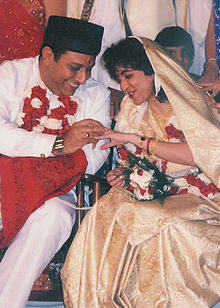Zoroastrian wedding
In recent times however, it is not uncommon for this system to be reversed, with the parents consulted about a decision made by the marrying parties.
On this day the groom's family visits the bride's home to present her with all the gifts like clothes and jewelry.
The relatives, neighbors and friends are treated to a traditional meal of sev and dahi, boiled eggs and bananas.
The first day of these is known as mândav-saro, when a twig of a tree, generally a mango-tree, is planted near the door, symbolic of a wish for fertility.
With the marriage ceremony occurring in the evening of the fourth day the bride and bridegroom will have prior taken baths, known as nân.
[2] The ceremonial dress of the Parsees is the Jâmâ-pichhoir of which the bride wears a white variety, with the bridegroom sporting the mark of a Kunkun on his forehead.
A few hours before the ceremony a procession forms carrying gifts to the bridegroom's house, usually accompanied by music.
A similar ritual is then performed with a coconut, and then with a small tray of water which is thrown to the ground.
The senior priest then blesses the couple by saying: May the Creator, the omniscient Lord, grant you a progeny of sons and grandsons, plenty of means to provide yourselves, heart-ravishing friendship, bodily strength, long life and an existence of 150 years!Various questions are then asked to the bride, groom and witnesses.
Once they have replied, affirming that they have entered into this with righteous mind the priest will recite admonitions and benedictions.
A wedding feast then occurs at which toasts are made to God, the couple, the sacred fire temples, the guests and the host.

